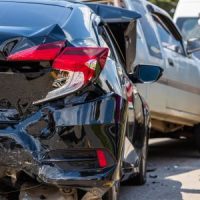Liability for Three-Car Rear-End Accidents

Determining fault for a car accident is hard enough when only two vehicles are involved. Things can become even more complex, however, when three or more vehicles collide in a chain reaction rear-end crash. While many assume that the driver at the back will be held liable for the entirety of these kinds of crashes, the reality can be much more complicated. In fact, it is possible that the driver of the middle vehicle will be held liable for some of the collision, while in other cases, all three parties could bear some responsibility.
Presumption of Liability
In most rear-end accident cases, the driver of the car that strikes the vehicle in front of it is automatically presumed to be at fault for the crash. This is because in Georgia, all drivers are required to keep a safe distance from other vehicles, so as to stop in a timely manner and avoid a crash. The reality, however, is a bit more complicated, especially when more than two cars are involved. While it is still common for the driver in the rear to be held partly responsible, it is still possible for the other drivers to be assigned a degree of liability.
Apportioning Fault Between Three Drivers
In a three-car rear-end accident scenario, the motorists involved are the driver of the lead car, the driver of the middle car, and the driver of the rear vehicle. Because the actions of each driver could have a bearing on the cause of an accident, determining liability for the crash will require a consideration of each driver’s potential contribution.
The driver of the front vehicle often escapes liability for rear-end collisions because of Georgia’s legal presumption that the driver of the rear vehicle is responsible for avoiding a crash. However, the driver of the lead vehicle could be held partially responsible for the accident if the initial collision was caused by erratic driving, violating a traffic law, or defective brake lights. The driver of the middle car, which struck the lead vehicle, may also be held partially liable for the crash if he or she was deemed to have been driving too closely or speeding. It is the driver of the rear vehicle, however, who is most likely to be held liable for the majority of the accident’s damages and injuries. Again, this driver’s percentage of fault could end up being lowered if the driver of the middle vehicle was negligent.
Modified Comparative Negligence Standard
This apportioning of fault for an accident is possible due to Georgia’s modified comparative negligence law, under which multiple people can be held legally responsible for an accident. In these cases, the amount that each party can recover in damages will also be reduced in proportion to their degree of fault in causing the crash. Only when a party is found to be more than 50 percent at fault for a crash will he or she be barred from recovery entirely.
Get in Touch with Our Atlanta Legal Team
Determining fault for a three-car rear-end accident is difficult and requires an in-depth investigation into the cause of the crash. At Shiver Hamilton Campbell, our experienced Atlanta rear-end accident lawyers are well-versed in conducting these kinds of investigations. Call our office at 404-593-0020 to get started on yours.
Sources:
forbes.com/advisor/legal/auto-accident/rear-end-collision/
law.justia.com/codes/georgia/2020/title-51/chapter-12/article-2/section-51-12-33/


